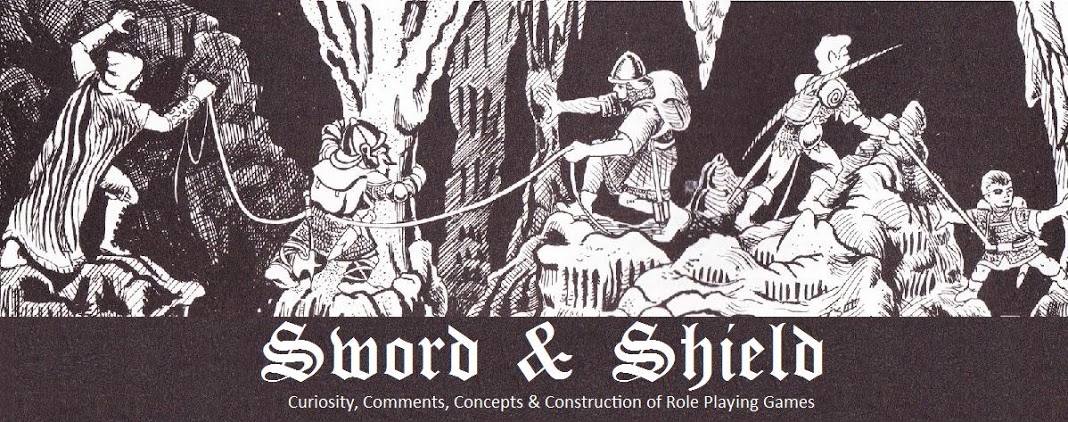Updated 4/1/18
Sword & Shield is a rules light, tabletop RPG in development by Christopher Brandon. A few weeks ago I stumbled across the Brandon’s blog for the system. Check it out at Swordandshieldrpg.blogspot.com along with his other works. Soon after discovering Sword & Shield our weekly D&D session was canceled. After a short conversation I offered to run the play test adventure for one of the players and his two boys. It was a rousing success. The boys (four and five years-old) handled the simple rules and the straightforward dungeon delve held their attention.
The Nuts & Bolts
The play test rules have three classes: Fighter, Thief, and Wizard. The short character details can fit on an index card. Each class has a polyhedral die assigned to the abilities Fight, Shoot, and Magic. Fight for melee combat, Shoot for ranged, and Magic for casting spells and resisting magic/status effects. The system uses opposed rolls for conflict resolution. Additionally, there’s a generic Skill ability for checks like climbing, tracking, lock picking.
What Sword & Shield Does Well
What the system does well is quick combat. Melee combat represents not one attack but a flurry of attacks. Attacking a creature and failing can end with the instigator taking damage. Turns are quick and combat can be quite dangerous. One combat ended with the party fleeing and hiding after a few rounds of attrition against a living statue. The best compliment you can give a rules light system is it is easy to pick up and play.
Shortcomings
Sword & Shield does have some shortcomings. The encumbrance rules are harsh. Donning armor and adventure essentials can leave characters over-encumbered and slow. For the playtest we tossed out encumbrance as being difficult for the boys (fractions). The Luck mechanic seems out of place. Luck points allow a character, once per level, to turn a failed check into a success. It seems easier to omit the Luck mechanic as currently written. Damage also suffers from a small dilemma. A wizard with a d4 Fighting die using a light weapon will never damage a creature with an armor reduction score of four or better. This came up during the play test as the wizard did not take any damage dealing spells.
Suggested Improvements
Development is currently halted for Sword & Shield. That’s unfortunate, I would play Sword & Shield again with a few house rule changes.
Encumbrance
Change the encumbrance rules to -1 Movement for each ½ hit points of encumbrance. This should allow parties to still be able to run away from combat and let them carry gear and loot.
Luck
Reduce Luck points per play session. Each use counts as rolling the highest possible result on the die for the check in question. Gaining levels will give players extra points of Luck to use for failed checks.
Initiative
The Party Leader for each faction rolls initiative. I would like individual initiative to spice things up and keep the wizard from casting Dazzle on the BBEG at the start of every combat.
Minimum Damage
Allow successful attacks to do a minimum of one damage.
A wizard with a dagger attacks a fighter wearing chain mail and using a shield. The wizard rolls four on his d4, and the fighter rolls a 1 on his d8. 3 (difference of the rolls) + 1 (damage bonus for dagger) = 4 points of damage. The fighter has armor 4. In the basic rules the fighter would never take damage from the wizard. Minimum damage rules makes any successful attack deal at least one damage.
Hit Points
I like the idea of rolling hit dice as a general rule. But it can also be disastrous if you roll bad. In our playtest the thief ended up with the most HP, six at level one. The fighter had three. With minimum damage rules the fighter could die easily in melee. There are loads of HP mechanics out there. For first level I would at least change to make starting HP at least ½ the hit die rounded down. Roll a ten, the fighter starts with 11 HP. Roll a one, the fighter starts with minimum six HP rather than two. Fifth edition Hackmaster has some sound, if cumbersome bookkeeping, mechanics for HP progression.
Experience
As a rule of thumb I throw out calculating experience points for leveling up. I find it natural to level up characters when it seems appropriate rather than an extended rest at point X in dungeon Y. Sword & Shield’s XP system takes extra work to calculate. As written it takes longer to level low-level parties than high level parties who can handle stronger monsters.
Streamline Task Resolution
The most difficult thing to remember in the playtest was which tasks DCs you have to meet and which you have to beat. Fight, Shoot, and Magic checks you have to BEAT the opposing die roll. But you only have to MEET for Skill checks. For simplicity sake choose one or the other. As lock picks grant a +1, use the Beat mechanic. Our playtest saw the wizard fail to cast Heal many times as I continued to roll eights on the Challenge Die.
Summary
I am salivating to play Sword & Shield again. It is a breeze to run and simple to pick up and play for those not baptized by tabletop RPGs. I will keep the playtest rules around as an introductory system for new players interested in learning RPGs.
Download the play test rules and adventure and let me know what you think!


Pingback: From the Dice of Babes | Red Ragged Fiend